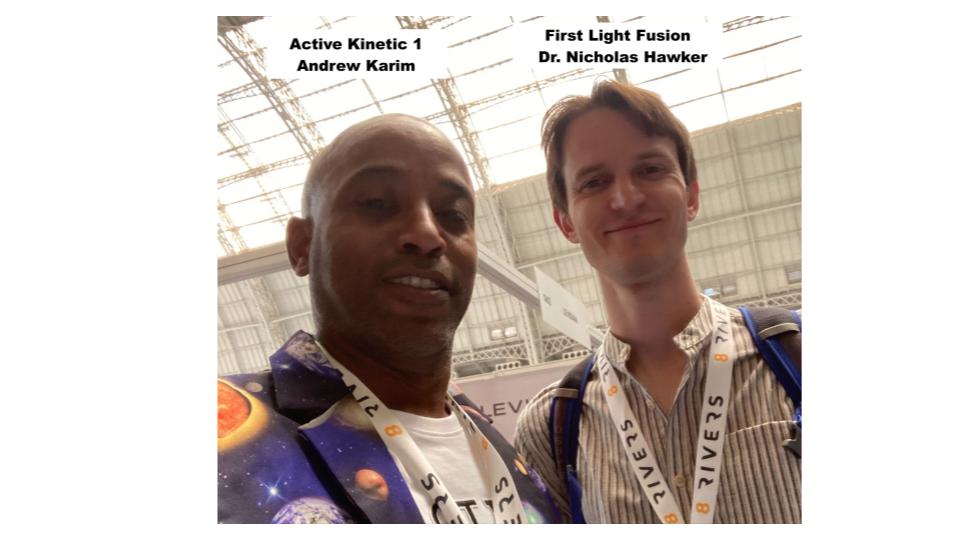Fusion’s Active Kinetic Energy
First Light Fusion, CEO, Dr. Nicholas Hawker talks fusion with Active Kinetic 1 Founder.
A combination of fusion and kinetic energy technologies will enable limitless energy anywhere in the universe and we are extremely close to a new variety of solutions.
The energy revolution is well underway. Understanding the interaction requires an average mindset. As confirmed by Dr. Nicholas Hawker, Co-Founder & CEO from First Light Fusion, during fusion, the atomic nuclei undergo a process called nuclear fusion, where they collide and fuse together. This fusion process requires a tremendous amount of energy to overcome the electrostatic repulsion between the positively charged nuclei. When the nuclei overcome this repulsion and fuse, they release energy in the form of kinetic and thermal energy.
The kinetic energy is a primary source of electricity, while the thermal energy serves as a secondary source to drive such systems as turbines.
By utilising the containment of thermal energy drives the steam turbine attached to a dynamo to generate electricity.
Although work has already begun to create a thermal powered fusion system, it is indeed evident that forces from kinetic energy could provide far more energy and even portability.
Dr. Nicholas Hawker explained that matter formed during fusion is released from the fusion reaction and emits a huge kinetic force that is contained by surrounding enclosures.
As a fusion reaction occurs in a split second, the force of movement would shred any gear system constructed. Hence the kinetic energy from fusion is useless to drive a dynamo.
The knowledge share was conclusive that Active Kinetic 1 generators provide an improved solution to generate electricity and conserve kinetic energy currently lost during the fusion process. A kinetic fusion technology has the potential to increase output by megajoules.
The First Light Fusion pilot plant is expected to generate 150 MW of electricity using thermal energy and will be completed by the 2030s with costs less than $1 billion.
The Science
Most fusion reactions are achieved by heating and compressing a plasma of light atomic nuclei to extremely high temperatures and densities. Whereas, First Light Fusion use a cost efficient projectile propelled by an assembly of electromagnetic similar to a railgun. The projectile collides with the target at speeds of 14,540mph. The collision forces the projectile to crush the target containing the fuel cell, causing it to collapse and implode. The fuel pellet is compressed from several millimeters down to less than 100 microns forcing the fusion reaction to release neutrons, heat energy and kinetic energy.
When a fusion reaction occurs, high-speed particles such as neutrons, protons, and alpha particles are produced. These particles carry kinetic energy due to their motion. The force exerted by these particles can be calculated using Newton’s second law of motion, which states that the force (F) is equal to the mass (m) of an object multiplied by its acceleration (a). Mathematically, it can be expressed as F = ma.
In fusion reactors and experimental setups, various materials are used to handle the forces and energy generated by the fusion reaction. The selection of materials depends on factors such as temperature, radiation levels, neutron flux, and the specific design of the fusion system. These materials could be designed to release controlled levels of kinetic energy generating megajoules from active kinetic electricity.
The principle of “every action produces an equal and opposite reaction” is a fundamental concept derived from Newton’s third law of motion, which applies to the motion of objects in the context of classical mechanics for capturing the kinetic energy used by active kinetic generators.
In the case of fusion, the reactions occur at the atomic or subatomic level. Governed by the laws of quantum mechanics, Fusion reactions involve the combination of atomic nuclei to form a heavier nucleus. This process releases a large amount of energy, primarily in the form of electromagnetic radiation (thermal energy) and kinetic energy, as explained earlier.
Fusion reactions, such as those occurring in the Sun or in experimental fusion reactors, involve the fusion of light atomic nuclei, typically isotopes of hydrogen. The fusion process requires extremely high temperatures and pressures to overcome the electrostatic repulsion between positively charged nuclei.
During fusion, the combined mass of the product nucleus is slightly less than the sum of the masses of the initial nuclei. This mass difference is converted into energy according to Einstein’s famous equation, E=mc², where E represents energy, m represents the mass difference, and c represents the speed of light. This conversion of mass into energy is what powers fusion reactions.
In fusion reactions, the energy released in the form of radiation and kinetic energy is not a result of a direct reaction and its opposite reaction, but rather the result of the conversion of a small amount of mass into energy. The laws of conservation of energy and mass are respected in these reactions.
Therefore, while Newton’s third law applies to macroscopic objects in classical mechanics, it is not the principle that governs the release of energy in fusion reactions. The principles of quantum mechanics and the conversion of mass into energy, as described by Einstein’s equation, play a central role in understanding and explaining the energy release in fusion processes.
The radioactive elements in fusion are far less than in Nuclear fission, so the fusion chamber can be adapted to harvest the kinetic energy.
In reality, using active kinetic generators even a fossil fuel combustion system might be converted to harvest kinetic energy saving vast amounts of energy loss.
This by chance meeting at Innovation Zero has provided lots of insight into the world of fusion energy, I believe my suit gravitated me to meet with some interesting people and minds with similar predictions in technology.
Using kinetic energy for Fusion and various other sources of energy will increase energy output, the energy mix and increase substantially.



Leave a Reply